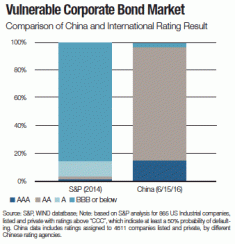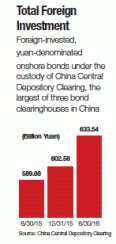To view a PDF of the report, click here.
By Eric Johnson
China’s transition to a market-based, globally integrated economy has spanned nearly four decades, marching progressively forward but at a tortoise-like pace that even Beijing policymakers readily admit has been slow.
“China has gone through a long period of transition,” the nation’s central bank chief, Zhou Xiaochuan, acknowledged in June at an International Monetary Fund event in Washington.
Yet China’s lumbering tortoise also has a reputation for breaking into sprints whenever prodded by market-jolting reforms. One such jolt came last February, when Zhou’s People’s Bank of China (PBOC) lifted all restrictions on foreign institutional investor participation in what’s now a nearly US$ 9 trillion bond market – the world’s third-largest debt securities deck, behind only the United States and Japan.
Global investors took note immediately. Analysts started hammering out reports. Asset managers rethought their China portfolios. And potential bond issuers from state-owned enterprises (SOEs) to local governments in China’s fast-growing cities saw in the PBOC decision fresh incentive to streamline debt management according to international norms.
Weighing in with a China bond market endorsement was the World Bank, which August 12 said PBOC had approved its request to issue about US$ 2.8 billion worth of bonds denominated in its Special Drawing Rights (SDR) “currency” and payable in yuan. “We are very pleased to support China’s growing role in global financial markets,” said World Bank Group President Jim Yong Kim.
Meanwhile, among institutional investors familiar with the China playing field and its lengthy transition, the usual questions resurfaced. They asked: What’s the risk? Has China SOE corporate governance improved enough that fixed-income investors can safely supplement the easy credit extended by government-owned banks? Are indebted city governments shifting to more transparent budgeting practices in ways that can accommodate conservative bond holders? How might opening the debt securities market affect China’s strict controls on capital movement and currency exchange? And what about China’s domestic bond ratings system... is it really reliable?
Of course, straightforward answers seldom come easily in China. Like the nation’s still-evolving financial markets, and like the entire business environment, the market transition process has never been formulaic. The regulator rulebook, for example, is dynamic, subject to rapid adjustments and regional variations. City hall budgeting in a northeastern steel town, for example, may differ significantly from how things work in the southern metropolis of Shenzhen. Bond-issuing SOEs controlled by provinces and central-government SOEs are not necessarily alike. Cultural factors influence corporate governance.
Indeed, bond market operations have been shadowed by the same questions confounding foreign companies vying for consumer market share in the world’s second-largest economy. Questions resurface whenever government regulators target a foreign company for alleged missteps, or a multinational throws in the towel. Uber sold out this year, Google left in 2010, and Danone exited in 2009.
That authorities are now keen on attracting foreign investors into Chinese bonds reflects a deep interest in letting market forces decide the fate of indebted companies and state-owned enterprises in the context of the nation’s economic slowdown, now in its sixth year. Bank non-performing loan ratios early in the second half 2016 were creeping toward 2 percent.
Beijing also sees a foreigner-friendly bond market as a preferred alternative to the so-called “local government financing vehicles,” shadow banking and dicey credit schemes that governments and many companies traditionally have relied upon whenever state banks, often under government orders, tighten lending.
Moreover, the bond market has obviously matured to the point where authorities feel comfortable about inviting overseas institutional investors. The market’s strengths and weaknesses are now more apparent than ever, and mainland asset managers and bankers are confident they can offer foreign clients a well-lit road that’s wide enough for reasonably low-risk navigation.
Directing traffic are three clearinghouses: the China Central Depository Clearing (CCDC), Shanghai Clearing House (SCH), and China Securities Depository and Clearing (CSDC). The first two handle interbank bond trades, while the third generally focuses on bonds traded on the Shanghai and Shenzhen stock exchanges.
CCDC, which focuses on government bonds, reported 40.08 trillion yuan (about US$ 6.12 trillion) worth of bonds under custody as of June. CSDC said bonds in its custody had a combined market capitalization of 5.53 trillion yuan (US$ 834 billion). Some 90 percent of CSDC’s paper trades on the Shanghai Stock Exchange, the rest on the Shenzhen Stock Exchange. SCH, which handles a variety of corporate bonds and interbank certificates of deposit, pegged its custody total at 13.61 trillion yuan (US$ 2.05 trillion) in August.
These figures are so big that hard-to-answer questions – including questions that have been around for decades – obviously won’t stop global investors from knocking on China’s door.
“Foreign investors can’t afford not to have a stake in what may eventually be the biggest bond market in the world,” explained Edmund Goh, the Asia fixed-income team investment manager at Aberdeen Asset Management, which has US$ 96 billion in fixed-income assets under management.
It’s also been argued that the latest bond reform should be viewed as part of a financial infrastructure-building process that, although incomplete, deserves both trust and institutional investor support.
“China’s bond market on the whole offers opportunities that more than offset the risks,” said Jacqueline Zhang, assistant general manager of Ping An Asset Management, which as of December 2015 reported 1.6 trillion yuan worth of fixed-income assets under management. “It remains a blue ocean worthy of offshore investor interest.”

| 
|
| Jacqueline Zhang Ping An Asset Management | Edmund Goh Aberdeen Asset Management |
| “China’s bond market on the whole offers opportunities that more than offset the risks. It remains a blue ocean worthy of offshore investor interest.” | “Foreign investors can’t afford not to have a stake in what may eventually be the biggest bond market in the world.” |
After noting that corporate bond defaults had jumped in the first half of 2016, a recent Bank of China analysis frankly predicted a further increase in defaults in the second half. But rather than fueling fear, the report said, these defaults actually prove that the market transition is having a desired impact on the corporate landscape.
Indeed, at earlier stages of the transition, defaults were often prevented by governments keen to bail out taxpaying SOEs with big payrolls and official influence. Implicit bailout guarantees emboldened SOEs to build beyond customer demand, distorted retail investing and saddled banks with toxic and near-toxic debt. Accenting this no-fail attitude was a network of unregulated credit systems.
Efforts to end bailout guarantees, consolidate SOE operations and rein in shadow banking through stricter regulations were reform steps built into the market transition process in recent years. Now, bond defaults are being allowed.
“A default is an inevitable phenomenon in a market-oriented bond market,” said the Bank of China report. “A rising probability of default properly reflects economic cycle developments.”
Moreover, the report said, the bond market that’s now been opened to foreign investors is “equipped to manage and absorb default risk” through “risk control within the scope of what the market can bear.”
Sharing that assessment is Liu Qingchuan, a managing director and IB bond section chief at China International Capital Corp. Ltd. (CICC), one of China’s leading investment banks.
“If no one defaults, then all credit risk is equal... and there’s no risk premium. Everyone looks the same,” said Liu. “It’s healthy for the bond market to see some defaults.”
JP Morgan Chase analyst Xie Tong recently told the Chinese magazine Caixin that bond market reforms are simply part of a system building project. It only makes sense to “have the roads laid out and financial infrastructure and institutions built first,” Xie said.
And Ping An’s Zhang isn’t worried. She said the current hazard level associated with the nation’s economic slowdown is “not severe enough to result in large-scale defaults or systemic risk.”
Holding Back
Before the February reform, a limited number of yuan-denominated bonds issued by China’s central and local governments, SOEs and other entities were available to foreign firms and sovereign wealth funds, mainly through the nation’s quota-based Qualified Foreign Institutional Investor (QFII) and Renminbi Qualified Institutional Investor (RQFII) schemes. The number of overseas participants had gradually increased after a small batch of foreigners became the first invited to buy bonds in 2010, reaching 328 institutional investors on June 30, according to CCDC.
QFII-RQFII players were on board in 2014 when Beijing introduced a reform program that, in a key market jolt, for the first time gave local governments permission to issue municipal bonds. Previously, only the central government’s Ministry of Finance and so-called financing vehicles could issue bonds on behalf of local governments to raise money for public works and other civic projects.

Nevertheless, neither the 2014 decision nor any other reform measure apparently went far enough to attract more than a smattering of overseas investment. According to the State Administration of Foreign Exchange (SAFE), foreign investors held less than 2 percent of all outstanding bonds by value last January.
The foreign share of the market climbed modestly after the bond reform announcement. As of June, some 2.6 percent of the interbank market’s investors were foreign, while offshore institutions held 1.3 percent of the total available through China’s bond market.
The reform has added to the foreign inflows that had been steadily rising in recent years through QFII and other schemes. Between 2013 and June, Zhang said, offshore institution bond holdings doubled to US$ 105 billion. CCDC said 48 percent of that amount was in government bonds, 43 percent in paper for banks and other financial institutions, and the rest in corporate bonds.
So far, foreign investors have been playing it safe. Most of Aberdeen’s holdings, for example, are in China’s central government bonds “since they are the most liquid,” Goh said. “We may consider municipal bonds in the future. But currently, the yield spreads against CGBs are pretty tight, and liquidity is a problem. Some SOEs offer attractive spreads against CGBs, especially relative to similar credits in local currency markets elsewhere in the region. However, there are coupon taxes to consider with non-government bonds.”
In Goh’s opinion, foreign participation “will continue to rise, assuming China continues to open up the bond market to foreign investment. However, we doubt foreign ownership will jump dramatically in the short term.”
What’s holding back foreign players? It’s not a lack of opportunity, as underscored by a boom in bond demand in the first half of this year that CICC expects will continue in the second half. A CICC report said “ample liquidity and a scarcity of quality bonds” offer “the strongest logic” for the boom, which has been led by domestic investors, who vastly outnumber their foreign counterparts.
“As a shortage in quality assets would force financial institutions to increase their exposure to bonds, we have also suggested that the supply of bonds may start to fall from the second half 2016 onward,” the report said. “Rising demand and falling supply may help sustain the boom in the bond market.”
Still, the negatives are nagging for many foreign investors.
One factor to consider is China’s unique, foreign currency exchange system. A sharp devaluation of the yuan in August 2015 that caught investors by surprise has not been forgotten, as it underscored what many say is an unpredictable system managed by PBOC and SAFE. Goh expressed a common opinion: “Most (foreign) investors will carefully consider the currency risk before committing” to China bonds, he said.
The credit rating system, which is run by Chinese firms such as Dagong Global Credit Rating, has also been shadowed by doubts. Goh called ratings in China “unreliable” and one of the “big impediments to foreign investors pouring money into the China bond market.”
A recent Credit Suisse analysis called credit ratings “the Achilles heel” of the China corporate bond market and argued that the issue of implicit government support for SOEs, no matter how badly managed and indebted, has yet to be resolved.
“China’s corporate bond rating seems to not only reflect the financial position of the company but assumes that it will be somehow bailed out in case of any repayment problems,” the report said. “This is not an optimal practice. Indeed, when default risks started to emerge in April, corporate bond market activities shrank rapidly.”
Liu, however, sees the ratings environment in an entirely different light. Only domestic agencies have what it takes to examine bonds in the China context, he said, particularly the hard-to-recognize relationships between a bond issuer and one or more government entities.
“Rating is an art, not a science,” Liu said. “Ratings agencies don’t predict the chance of a default. It’s all about opinions, perspectives. Dagong has its China-based perspective.”

Credit Suisse argued, however, that Chinese corporate bonds are more likely than counterparts in other countries to rate AAA and AA. The number of Chinese bond issuers with AAA and AA ratings as of June were 15 percent and 81 percent of the total, respectively, compared with 0.5 percent and 1.7 percent of those U.S. industrial companies rated by S&P in 2014, the report said.
And among those publicly listed companies in China that have been listed by Chinese rating agencies as well as S&P, the rating “gap is rather large,” the report said. “It could be argued that the difference mainly lies in the different perception of a ‘soft guarantee’ (of a government bailout, if needed) by domestic and foreign rating agencies.”
So how an international investment firm responds to China’s latest invitation to buy bonds may ultimately reflect trust in the government’s ability to deliver growth and steer the economy forward through good times and bad, even if that means moving as slowly as a tortoise.
Goh explained that Aberdeen’s allocation to China onshore debt had been “pretty stable over the past few years” before the bond reform took effect because QFII quota restrictions “made it difficult for us to move capital in and out of the country.” Moreover, he said, the yuan “is still a currency that operates under many restrictions.”
The environment in the months since the reform was introduced in February has not changed significantly, Goh said.
“However, with the opening up of the China interbank bond market to foreigners, giving us greater access without having to rely on the QFII and Renminbi Qualified Foreign Institutional Investor schemes, we would consider increasing our exposure,” Goh said.
Indeed, among institutional investors it’s now vitally clear that this tortoise can really sprint.
In his IMF address, the PBOC’s Zhou said the regulatory structure for overseeing China’s financial markets – including the bond market – has been specifically designed for a long-haul transition to a market economy. There are no shortcuts. Yet Zhou said he’s confident the nation’s goals will be reached.
“China has gone through a long period of transition which has been reflected in the PBOC’s institutional arrangement,” Zhou said. “Ultimately, the transition to a market economy will, by and large, be completed.”
| Why Trust China’s ‘One Switzerland Every Year’ Economy? China’s economy is cooling and debt levels are rising. Should these conditions scare off potential bond investors?
|
| What’s Available to Foreign Investors? A recent Credit Suisse report co-authored by Hong Kong-based analysts Vincent Chan and Shen Hu offered the following run-down of the three types of bond issuers now open to foreign investors through the onshore, interbank market in China:
|
| Sidebar: Who Can Trade China Bonds? The new bond market playbook calls on foreign institutional investors to hire an interbank bond market agent to handle trading and settlement, according to the market consultancy Z-Ben Advisors. A trading license is not required, although firms must register with agents at the Shanghai office of the People’s Bank of China. Foreigners can access the interbank bond market through any of 18 settlement agency banks. Permitted investor types include offshore banks, insurance companies, securities firms, FMC managers and products, and other asset managers including pension funds, endowments, foundations and special investors recognized by the central bank. |





